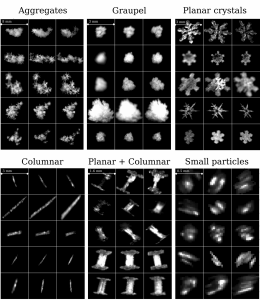Radar retrieval of snowfall microphysics
Properly modeling snowfall for weather and climate applications requires knowledge of the “microphysics of snowfall”, that is, a microscale description of snow particles and of the mechanisms by which they form, grow, and decay.
Remote sensing techniques and, in particular, meteorological radars, can provide decisive insights into snowfall microphysics.
In addition to usual radar variables, the Doppler spectrum measured by vertically-pointing radars allows separating the echo of hydrometeors (e.g., snowflakes or raindrops) as function of their downward velocity. This reveals how the radar signal is distributed between large, fast-falling, and small, slow-falling particles, and enables more refined analyses of snowfall.
In this project, we developed a new method to estimate, from measurements of Doppler spectra, a number of microphysical properties of snowfall – such as the mean particle size, the aspect ratio, the number concentration of snow particles – in the entire atmospheric column.
For this, we relied on a deep learning framework, which helped mitigate some of the issues encountered with classical retrieval methods.
The method was implemented using data from the ICE GENESIS campaign that took place in the Swiss Jura in 2021. We could compare the results of our retrieval to actual in-situ measurements of snowfall properties collected with sensors on board a scientific aircraft. The results are encouraging, and they open up possibilities to characterize snowfall properties in an accurate and detailed way, contributing to potential future improvements of weather and climate models.

Examples of results obtained with the retrieval algorithm. These are height-time plots (x-axis: time, y-axis: height above ground) of two important properties of snowfall: top panel, the ice water content describes the total mass of snow per unit volume of air; bottom panel, the mean diameter of snow particles at a given time and height.
Researcher: Anne-Claire Billault-Roux
DisdroDB – A global disdrometer data archive
The DSD describes the number and size distributions of raindrops in a volume of air. It is key to model the propagation of microwave signals through the atmosphere (crucial for telecommunication and remote sensing, to improve microphysical schemes in NWP models and to understand rain-related land surface processes (i.e. rainfall interception, soil erosion).
Despite its importance, the spatial and temporal variability of the DSD remains poorly understood. This has motivated scientists all around the globe to deploy DSD recording instruments known as disdrometers, in order to collect DSD observations in various climatic regions. However, only a small fraction of this data is easily accessible. Data are stored in disparate formats with poor documentation, making them difficult to share, analyze, compare and reuse. Additionally, very limited software is publicly available for DSD processing.
To this end, we undertake an initial effort to index, collect and homogenize DSD data sets across the globe, as well as to establish a global standard for DSD observation sharing. The envisioned open-source global database of well-maintained and homogenized disdrometer data (DISDRODB) aims to accelerate and advance precipitation research by promoting the mobilization of data archives currently scattered across various institutions. The figure below illustrates the current spatial coverage of the centralized data archive.
The DISDRODB software is currently available at https://github.com/ltelab/disdrodb.

Current and future spatial coverage of the DISDRODB database
Researcher: Gionata Ghiggi
Snowfall microphysics from in situ measurements
Individual snow crystals or larger snowflakes naturally occur in an incredible variety of shapes, sizes and types. The appearance of a snowflake, as we observe it just before it deposits on the ground, is in fact the combined result of all the environmental conditions encountered during its descent, from the cloud top to the ground, and of the mechanical interactions with other snowflakes or with liquid water droplets.

Example of good quality images of individual snowfall particles, classified according to Praz et al 2017. Images collected with a Multi-Angle Snowflake Camera (MASC)
There are still several open questions regarding the small-scale microphysical properties of snowflakes, many of them revolving around the estimation, evolution and variability of their mass, size, density or habit within precipitation systems.

Example of geometrical descriptors that can be used to characterize snowfall particles from 2D images collected with a MASC (Multi-Angle Snowflake Camera)
Knowledge often starts from observations and in the last years a significant momentum for snowfall microphysics has been promoted by the development of instruments designed to continuously collect high resolution images of (individual) snowflakes in free fall, for example the Multi-Angle Snowflake Camera (MASC). High resolution pictures can be used to automatically classify snowflakes, to infer their physical properties and, in combination with simulations and machine learning techniques, even to reconstruct their mass and three dimensional structure.

Schematic concept of data processing sequence for raw MASC (Multi-Angle Snowflake Camera) images of falling snowflakes stored into four descriptor databases and one image store
Contact: Jacopo Grazioli